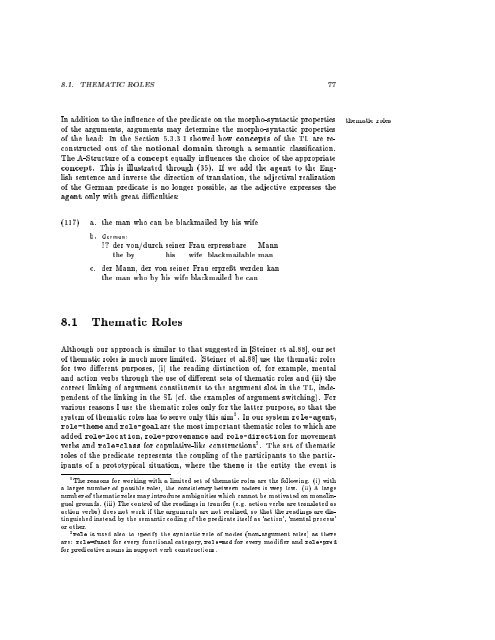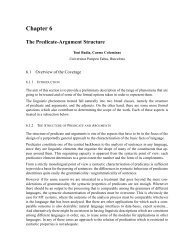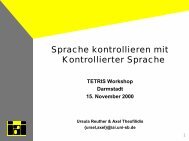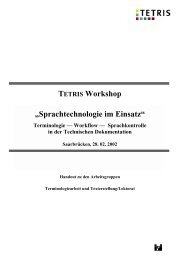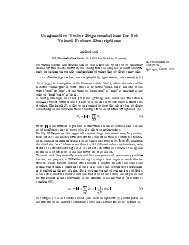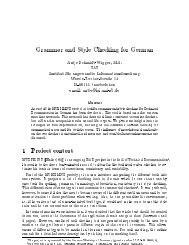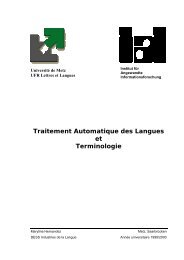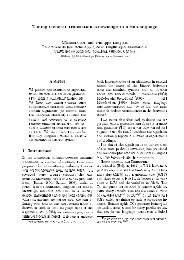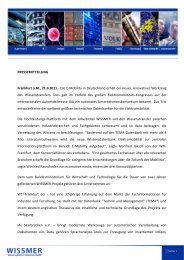Linguistic Modeling for Multilingual Machine Translation
Linguistic Modeling for Multilingual Machine Translation
Linguistic Modeling for Multilingual Machine Translation
Create successful ePaper yourself
Turn your PDF publications into a flip-book with our unique Google optimized e-Paper software.
8.1. THEMATIC ROLES 77<br />
In addition to the inuence of the predicate on the morpho-syntactic properties<br />
of the arguments, arguments may determine the morpho-syntactic properties<br />
of the head: In the Section 5.3.3 I showed how concepts of the TL are reconstructed<br />
out of the notional domain through a semantic classication.<br />
The A-Structure of a concept equally inuences the choice of the appropriate<br />
concept. This is illustrated through (35). If we add the agent to the English<br />
sentence and inverse the direction of translation, the adjectival realization<br />
of the German predicate is no longer possible, as the adjective expresses the<br />
agent only with great diculties:<br />
thematic roles<br />
(117) a. the man who can be blackmailed by his wife<br />
b. German:<br />
?? der<br />
the<br />
von/durch<br />
by<br />
seiner<br />
his<br />
Frau<br />
wife<br />
erpressbare Mann<br />
blackmailable man<br />
c. der Mann, der von seiner Frau erpret werden kan<br />
the man who by his wife blackmailed be can<br />
8.1 Thematic Roles<br />
Although our approach is similar to that suggested in [Steiner et al.88], our set<br />
of thematic roles is much more limited. [Steiner et al.88] use the thematic roles<br />
<strong>for</strong> two dierent purposes, (i) the reading distinction of, <strong>for</strong> example, mental<br />
and action verbs through the use of dierent sets of thematic roles and (ii) the<br />
correct linking of argument constituents to the argument slot in the TL, independent<br />
of the linking in the SL (cf. the examples of argument switching). For<br />
various reasons I use the thematic roles only <strong>for</strong> the latter purpose, so that the<br />
system of thematic roles has to serve onlythisaim 1 . In our system role=agent,<br />
role=theme and role=goal are the most important thematic roles to which are<br />
added role=location, role=provenance and role=direction <strong>for</strong> movement<br />
verbs and role=class <strong>for</strong> copulative-like constructions 2 . The set of thematic<br />
roles of the predicate represents the coupling of the participants to the participants<br />
of a prototypical situation, where the theme is the entity the event is<br />
1 The reasons <strong>for</strong> working with a limited set of thematic roles are the following. (i) with<br />
a larger number of possible roles, the consistency between coders is very low. (ii) A large<br />
number of thematic roles mayintroduce ambiguities which cannot be motivated on monolingual<br />
grounds. (iii) The control of the readings in transfer (e.g. action verbs are translated as<br />
action verbs) does not work if the arguments are not realized, so that the readings are distinguished<br />
instead by the semantic coding of the predicate itself as 'action', 'mental process'<br />
or other.<br />
2 role is used also to specify the syntactic role of nodes (non-argument roles) as there<br />
are: role=funct <strong>for</strong> every functional category, role=mod <strong>for</strong> every modier and role=pred<br />
<strong>for</strong> predicative nouns in support verb constructions.


